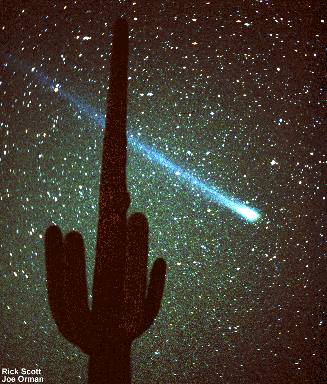Credit & Copyright: Rick Scott and Joe Orman,
near Florence Junction, Arizona, Courtesy
Night
of the Comet
Explanation:
Comet Hyakutake is shown photographed the night of March 27 in Arizona,
USA, with a cactus in the foreground.
Polaris, the north star, is the
bright star seen just to the upper right of the comet's head. Today Comet
Hyakutake reaches its closest approach to the
Sun. Comet Hyakutake is now
at its intrinsic brightest, but because of its distance from the
Earth, it
will appear less bright to us than it did during its closest approach to
the Earth in late March. In fact, due to the comet's angular proximity to
the Sun, it will difficult to see at all from the Earth! Comet Hyakutake
will reach less than one quarter of the Earth-Sun distance - inside the
orbit of Mercury.
Comet Hyakutake will
not venture near the Sun again for
another about 15,000 years.
Latest Comet Hyakutake images:
APOD Hyakutake Archive,
JPL,
Fayetteville
Observer-Times,
NASA's Night of
the Comet,
ICSTARS,
Jerry Lodriguss,
ScienceWeb,
Crni Vrh Obs.,
1999 2000 2001 2002 2003 2004 2005 2006 2007 2008 2009 2010 2011 2012 2013 2014 2015 2016 2017 2018 2019 2020 2021 2022 2023 2024 2025 |
Yanvar' Fevral' Mart Aprel' Mai Iyun' Iyul' Avgust Sentyabr' Oktyabr' Noyabr' Dekabr' |
NASA Web Site Statements, Warnings, and Disclaimers
NASA Official: Jay Norris. Specific rights apply.
A service of: LHEA at NASA / GSFC
& Michigan Tech. U.
|
Publikacii s klyuchevymi slovami:
comet Hyakutake - kometa Hiyakutake
Publikacii so slovami: comet Hyakutake - kometa Hiyakutake | |
Sm. takzhe:
Vse publikacii na tu zhe temu >> | |
